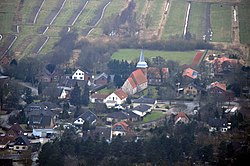Midlum, Lower Saxony
| Midlum | ||
|---|---|---|
| Ortsteil of Wurster Nordseeküste | ||

Aerial photo with St. Pancras Church
|
||
|
||
| Coordinates: 53°43′45″N 08°36′56″E / 53.72917°N 8.61556°ECoordinates: 53°43′45″N 08°36′56″E / 53.72917°N 8.61556°E | ||
| Country | Germany | |
| State | Lower Saxony | |
| District | Cuxhaven | |
| Municipality | Wurster Nordseeküste | |
| Area | ||
| • Total | 31.07 km2 (12.00 sq mi) | |
| Population (2013-12-31) | ||
| • Total | 1,681 | |
| • Density | 54/km2 (140/sq mi) | |
| Time zone | CET/CEST (UTC+1/+2) | |
| Postal codes | 27632 | |
| Dialling codes | 04741 | |
| Vehicle registration | CUX | |
| Website | www.midlum.de | |
Midlum (N. Low Saxon: Millm) is a village and a former municipality in the district of Cuxhaven, in Lower Saxony, Germany. Since 1 January 2015 it is part of the municipality Wurster Nordseeküste.
Originally Midlum was considered part of the Land of Hadeln. In 1219 six members of the family of the Lords of Diepholz, owning estates in and near Midlum, founded the Midlum Nunnery and endowed them to it. The Diepholz Lords then owned the Hollburg Castle between Holßel and Midlum on the brink of the Wesermünde Geest ridge, allowing a good view over the lower Land of Wursten, then a corporation of free Frisian peasants under only loose overlordship of the Prince-Archbishopric of Bremen.
Rather than establishing the nunnery as their proprietary monastery the Diepholz family made it over to the cathedral chapter of the Prince-Archbishopric of Bremen. However, the Diepholz family adopted the advocacy (Vogtei) over the nunnery, later passed on to the Knights of Bederkesa who were related by marriage.
In 1227 Prince-Archbishop Gebhard of Lippe confirmed and thus recognised the foundation of the convent. Midlum's St. Pancras Church, which existed before, was integrated into the convent. No remains of cloister or conventual outbuildings remain, and there are only few documentary references to them.
It is possible that the convent followed Cistercian customs without formal incorporation. The convent started the typical Cistercian practice to build up a large autark integrated production (Eigenwirtschaft). Unlike unsettled and undeveloped areas where Cistercians usually founded new monasteries the farmlands donated to the convent were held by feudal tenants and sparsed in and around Midlum.
...
Wikipedia


